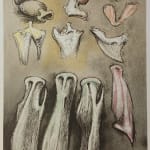Henry Moore British, 1898-1986
Three Sisters, 1981
Lithograph in colours on BFK Rives Wove
Signed and Numbered
Signed and Numbered
56.5 x 45cm (Unframed)
59 x 49cm (Framed)
59 x 49cm (Framed)
30/50
Copyright The Artist
Lithograph in colours on BFK Rives wove, Signed and numbered 30/50 in pencil Printed by J E Wolfensberger, published by Raymond Spencer, London Often regarded as the father of modern...
Lithograph in colours on BFK Rives wove,
Signed and numbered 30/50 in pencil
Printed by J E Wolfensberger, published by Raymond Spencer, London
Often regarded as the father of modern British sculpture, Henry Moore’s large-scale bronze and marble sculptures can be found in public parks and plazas around the world. Working in various styles and mediums, Moore is perhaps best known for his highly abstract and interpretive renditions of the human figure, often portrayed in the reclining position. He was influenced by Classical, Pre-Columbian, and African art, and by Surrealism; his biomorphic style has been compared that of Salvador Dalí and Jean Arp. Moore was a longtime friend and colleague of fellow sculptor Barabara Hepworth, having met at the Leeds School of Art around 1919. He also admired the work of Constantin Brancusi, whose organic abstract style resonated with Moore’s belief that observation of nature is essential to artistic creation. Moore himself inspired many artists including his former studio assistants Anthony Caro and Richard Wentworth.
Signed and numbered 30/50 in pencil
Printed by J E Wolfensberger, published by Raymond Spencer, London
Often regarded as the father of modern British sculpture, Henry Moore’s large-scale bronze and marble sculptures can be found in public parks and plazas around the world. Working in various styles and mediums, Moore is perhaps best known for his highly abstract and interpretive renditions of the human figure, often portrayed in the reclining position. He was influenced by Classical, Pre-Columbian, and African art, and by Surrealism; his biomorphic style has been compared that of Salvador Dalí and Jean Arp. Moore was a longtime friend and colleague of fellow sculptor Barabara Hepworth, having met at the Leeds School of Art around 1919. He also admired the work of Constantin Brancusi, whose organic abstract style resonated with Moore’s belief that observation of nature is essential to artistic creation. Moore himself inspired many artists including his former studio assistants Anthony Caro and Richard Wentworth.
Provenance
Printed by W.S. Cowell Ltd, published by The Baynard Press for School Prints Ltd, London1
of
4




